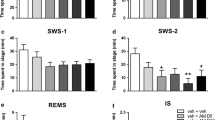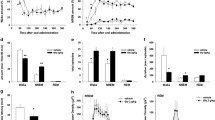Abstract
The present study was carried out to investigate the influence of GABAA signaling on sleep-like behaviors through systemic administration of bicuculline and picrotoxin (GABAA antagonists) and thiopental (an allosterical modulator). A thiopental (20 mg/kg) injection increased the eye closure frequency compared to the control group. The birds quickly became sleepy with a low frequency of early behavioral stages, such as rapid oral movement (ROM), feather ruffling and blinking. A bicuculline administration (1 and 4 mg/kg) did not modify the frequency of feather ruffling, ROM, eye closure or blinking responses. A lower dose of picrotoxin (2 mg/kg) stimulated an active awakening status, while an intermediate dose (4 mg/kg) elicited a moderate awakening status, which was associated with an increase in the frequency of ROM, blinking and eye closure. At the higher dose (8 mg/kg), the birds exhibited thermoregulatory-like behaviors and convulsions immediately after the injection. Interestingly, picrotoxin (4 mg/kg) intensified the eye closures when given in combination with thiopental (20 mg/kg). Both barbiturate and picrotoxin-induced sleep-like responses have the same behavioral neuropharmacological properties, conceivably because they are correlated with action at an identical site on the GABAA receptor.




Similar content being viewed by others
Abbreviations
- ROM:
-
Rapid oral movements
- BCC:
-
Bicuculline
- PTX:
-
Picrotoxin
- THIO:
-
Thiopental
References
Adachi N, Tomonaga N, Tachibana T, Denbow DM, Furuse M (2006) (−)-Epigallocatechin gallate attenuates acute stress responses through GABAergic system in the brain. Eur J Pharmacol 631:171–175
Ali M, Jha SK, Kaur S, Mallick BN (1999) Role of GABA-A receptor in the preoptic area in the regulation of sleep-wakefulness and rapid eye movement sleep. Neurosci Res 33:245–250
Argiolas A, Melis MR (1998) The neuropharmacology of yawning. Eur J Pharmacol 343:1–16
Ayala-Guerrero F, Mexicano G, Ramos JL (2003) Sleep characteristics in the turkey Meleagris gallopavo. Physiol Behav 78:435–440
Bormann J (2000) The ‘ABC’ of GABA receptors. Trends Pharmacol Sci 21:16–19
Campbell SS, Tobler I (1984) Animal sleep: a review of sleep duration across phylogeny. Neurosci Biobehav Rev 8:269–300
Cirelli C, Tononi G (2008) Is sleep essential? PLoS Biol 6:1605–1611
Colom LV, Saggau P (1994) Spontaneous interictal-like activity originates in multiple areas of the CA2-CA3 region of hippocampal slices. J Neurophysiol 71:1574–1585
Daquin G, Micallef J, Blin O (2001) Yawning. Sleep Med Rev 5:299–312
Denbow DM (1991) Induction of food intake by a GABAergic mechanism in the turkey. Physiol Behav 49:485–488
Fuchs T, Siegel JJ, Burgdorf J, Bingman VP (2006) A selective serotonin reuptake inhibitor reduces REM sleep in the homing pigeon. Physiol Behav 87:575–581
Glykys J, Mody I (2007) Activation of GABAA receptors: views from outside the synaptic cleft. Neuron 56:763–770
Gottesmann C (2002) GABA mechanisms and sleep. Neuroscience 111:231–239
Jayakumar AR, Sujatha R, Paul V, Puviarasan K, Jayakumar R (1999) Involvement of nitric oxide and nitric oxide synthase activity in anticonvulsive action. Brain Res Bull 48:387–394
Jonaidi H, Babapour V, Denbow DM (2002) GABAergic control of food intake in the meat-type chickens. Physiol Behav 76:465–468
Khisti RT, Mandhane SN, Chopde CT (1998) The neurosteroid 3α-hydroxy-5α-pregnan-20-one induces catalepsy in mice. Neurosci Lett 251:85–88
Lancel M, Faulhaber J, Holsboer F, Rupprecht R (1999) The GABA(A) receptor antagonist picrotoxin attenuates most sleep changes induced by progesterone. Psychopharmacology (Berl) 141:213–219
Langebartels A, Mathias S, Lancel M (2001) Acute effects of melatonin on spontaneous and picrotoxin-evoked sleep-wake behaviour in the rat. J Sleep Res 10:211–217
Lehmann HE (1979) Yawning: A homeostatic reflex and its physiological significance. Bull Meninger Clinic 43:123–136
Liu R, Jola T, Aghajanian G (2000) Serotonin 5-HT2 receptors activate local GABA inhibitory inputs to serotonergic neurons of the dorsal raphe nucleus. Brain Res 873:34–45
MacDonald RL, Twyman RE (1992) Kinetic properties and regulation of GABAA receptor channels. Ion Channels 3:315–343
Malleau AE, Duncan IJH, Widowski TM, Atkinson JL (2007) The importance of rest in young domestic fowl. Appl Anim Behav Sci 106:52–69
Polo PA, Reis RO, Cedraz-Marcez PL, Cavalcante-Lima HR, Olivares EL, Medeiros MA, Côrtes WS, Reis LC (2007) Behavioral and neuropharmacological evidence that serotonin crosses the blood-brain barrier in Coturnix japonica (Galliformes: Aves). Braz J Biol 67:167–171
Radil-Weiss T, Stýblová V (1967) Influence of thiopental on sleep cycles in rats. Psychopharmacologia 11:52–64
Rattenborg NC, Martinez-Gonzalez D, Lesku JA (2008) Avian sleep homeostasis: Convergent evolution of complex brains, cognition and sleep functions in mammals and birds. Neurosci Biobehav Rev [Epub ahead of print]
Rechtschaffen A, Bergmann BM (2002) Sleep deprivation in the rat: an update of the 1989 paper. Sleep 25:18–24
Sanford LD, Parris B, Tang X (2002) GABAergic regulation of the central nucleus of the amygdale: implications for sleep control. Brain Res 956:276–284
Taheri S, Mignot E (2002) The genetics of sleep disorders. Lancet Neurol 1:242–250
Takagi T, Ando R, Ohgushi A, Yamashita T, Dobashi E, Hussain-usuf H, Onodera R, Bungo T, Sato H, Furuse M (2001) Intracerebroventricular injection of pipecolic acid inhibits food intake and induces sleeping-like behaviors in the neonatal chick. Neurosci Lett 310:97–100
Takagi T, Bungo T, Tachibana T, Saito ES, Saito S, Yamasaki I, Tomonaga S, Denbow DM, Furuse M (2003) Intracerebroventricular administration of GABA-A and GABA-B receptor antagonists attenuate feeding and sleeping-like behavior induced by L-pipecolic acid in neonatal chicks. J Neurosci Res 73:270–275
Valverde A, Bienzle D, Smith DA, Dyson DH, Valliant AE (1993) Intraosseous cannulation and drug administration for induction of anesthesia in chickens. Vet Surg 22:240–244
Van Luijtelaar ELJM, Van Der Grinten CPM, Blokhuis HJ, Coenen AML (1987) Sleep in the domestic hen (Gallus domesticus). Physiol Behav 41:409–414
Wambebe C (1983) Influence of some GABAergic agents on nitrazepam-induced sleep in the domestic fowl (Gallus domesticus). Jpn J Pharmacol 33:1111–1118
Yamamoto I (2005) Studies on the structure-activity relationship of allyl substituted oxopyrimidines searching for the novel antagonist or agonist of barbiturates to the sleep mechanism based on the uridine receptor theory-barbituric acid to uridine (part I). Yakugaku Zasshi 125:73–120
Acknowledgments
The authors are grateful to Mr. Ipojucan P. Souza for animal care and technical assistance. This research was in part, supported by Conselho Nacional de Desenvolvimento Científico (CNPq). Animal handling and experimental procedures were performed according to the Guide for the Care and Use of Laboratory Animals published by the US National Institutes of Health (NIH Publication No.85-23, revised 1996) and conforms to pertinent Brazilian legislations and was approved by the institutional animal bioethics and welfare committee. Finally we are indebted to American Journal Experts for reviewing the manuscript.
Author information
Authors and Affiliations
Corresponding author
Rights and permissions
About this article
Cite this article
Polo, P.A., Mecawi, A.S., Lapa, M.A.P.C. et al. Study of GABAA receptors on the sleep-like behavior in Coturnix japonica (Temminck Schlegel, 1849) (Galliformes: Aves). J Comp Physiol A 195, 247–252 (2009). https://doi.org/10.1007/s00359-008-0402-7
Received:
Revised:
Accepted:
Published:
Issue Date:
DOI: https://doi.org/10.1007/s00359-008-0402-7




